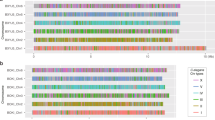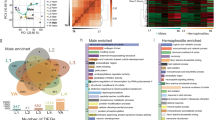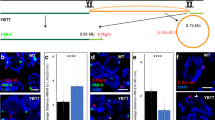Abstract
Organisms in many phyla determine sexual fate by distinguishing one X chromosome from two. Here we use the model organism Caenorhabditis elegans to dissect such an X-chromosome-counting mechanism in molecular detail. In this nematode, several genes on the X chromosome called X signal elements communicate X-chromosome dose by controlling the activity of the sex-determination gene xol-1 (refs 1, 2). xol-1 specifies male (XO) fatewhen active and hermaphrodite (XX) fate when inactive3,4. The only X signal element described so far represses xol-1 post-transcriptionally, but xol-1 is repressed in XX animals by transcriptional and post-transcriptional mechanisms2. Here we identify a nuclear-hormone-receptor homologue, SEX-1, that regulates the transcription of xol-1. We show that sex-1 is vital to X-chromosome counting: changing sex-1 gene dose in XX or XO embryos causes sexual transformation and death from inadequate dosage compensation (the hermaphrodite-specific process that equalizes X-gene expression between the sexes5). The SEX-1 protein acts directly on xol-1, associating with its promoter in vivo and repressing xol-1 transcription in XX embryos. Thus, xol-1 is the direct molecular target of the primary sex-determination signal, and the dose of a nuclear hormone receptor helps to communicate X-chromosome number to determine nematode sex.
This is a preview of subscription content, access via your institution
Access options
Subscribe to this journal
Receive 51 print issues and online access
$199.00 per year
only $3.90 per issue
Buy this article
- Purchase on Springer Link
- Instant access to full article PDF
Prices may be subject to local taxes which are calculated during checkout




Similar content being viewed by others
References
Akerib, C. C. & Meyer, B. J. Identification of X chromosome regions in C. elegans that contain sex-determination signal elements. Genetics 138, 1105–1125 (1994).
Nicoll, M., Akerib, C. C. & Meyer, B. J. X-chromosome-counting mechanisms that determine nematode sex. Nature 388, 200–204 (1997).
Miller, L. M., Plenefisch, J. D., Casson, L. P. & Meyer, B. J. xol-1: a gene that controls the male modes of both sex determination and X chromosome dosage compensation in C. elegans. Cell 55, 167–183 (1988).
Rhind, N. R., Miller, L. M., Kopczynski, J. B. & Meyer, B. J. xol-1 acts as an early switch in the C. elegans male/hermaphrodite decision. Cell 80, 71–82 (1995).
Meyer, B. J. in C. elegans II (eds Riddle, D. L., Blumenthal, T., Meyer, B. J. & Priess, J. R.) 209–240 (Cold Spring Harbor Press, New York, (1997).
Plenefisch, J. D., DeLong, L. & Meyer, B. J. Genes that implement the hermaphrodite mode of dosage compensation in Caenorhabditis elegans. Genetics 121, 57–76 (1989).
Hodgkin, J., Zellan, J. D. & Albertson, D. G. Identification of a candidate primary sex determination locus, fox-1, on the X chromosome of Caenorhabditis elegans. Development 120, 3681–3689 (1994).
Hodgkin, J. & Albertson, D. G. Isolation of dominant XO-feminization mutations in Caenorhabditis elegans: new regulatory tra alleles and an X chromosome duplication with implications for primary sex determination. Genetics 141, 527–542 (1995).
Kostrouch, Z., Kostrouchova, M. & Rall, J. E. Steroid/thyroid hormone receptor genes in Caenorhabditis elegans. Proc. Natl Acad. Sci. USA 92, 156–159 (1995).
Mangelsdorf, D. J. et al. The nuclear receptor superfamily: the second decade. Cell 83, 835–839 (1995).
Minucci, S. & Ozato, K. Retinoid receptors in transcriptional regulation. Curr. Opin. Genet. Dev. 6, 567–574 (1996).
Bourguet, W., Ruff, M., Chambon, P., Gronemeyer, H. & Moras, D. Crystal structure of the ligand-binding domain of the human nuclear receptor RXR-α. Nature 375, 377–382 (1995).
Renaud, J.-P. et al. Crystal structure of the RAR-γ ligand-binding domain bound to all-trans retinoic acid. Nature 378, 681–689 (1995).
Wagner, R. L. et al. Astructural role for hormone in the thyroid hormone receptor. Nature 378, 690–697 (1995).
Stone, B. L. & Thummel, C. S. The Drosophila 78C early late puff contains E78, an ecdysone-inducible gene that encodes a novel member of the nuclear hormone receptor superfamily. Cell 75, 307–320 (1993).
Harding, H. P. & Lazar, M. A. The monomer-binding orphan nuclear receptor Rev-Erb represses transcription as a dimer on a novel direct repeat. Mol. Cell. Biol. 15, 4791–4802 (1995).
Desbois, C., Aubert, D., Legrand, C., Pain, B. & Samarut, J. Anovel mechanism of action for v-ErbA: abrogation of the inactivation of transcription factor AP-1 by retinoic acid and thyroid hormone receptors. Cell 67, 731–740 (1991).
Ramkissoon, U. & Goodfellow, P. Early steps in mammalian sex determination. Curr. Opin. Genet. Dev. 6, 316–321 (1996).
Swain, A., Narvaez, V., Burgoyne, P., Camerino, G. & Lovell-Badge, R. Dax1 antagonizes Sry action in mammalian sex determination. Nature 391, 761–767 (1998).
Raymond, C. S. et al. Evidence for evolutionary conservation of sex-determining genes. Nature 391, 691–695 (1998).
Brenner, S. The genetics of Caenorhabditis elegans. Genetics 77, 71–94 (1974).
Fire, A., Harrison, S. W. & Dixon, D. Amolecular set of lacZ fusion vectors for studying gene expression in Caenorhabditis elegans. Gene 93, 189–198 (1990).
Williams, B. D., Schrank, B., Huynh, C., Shownkeen, R. & Waterston, R. H. Agenetic mapping system in Caenorhabditis elegans based on polymorphic sequence-tagged sites. Genetics 131, 609–624 (1992).
Chuang, P.-T., Albertson, D. G. & Meyer, B. J. DPY-27: a chromosome condensation protein homolog that regulates C. elegans dosage compensation through association with the X chromosome. Cell 79, 459–474 (1994).
Straight, A. F., Belmont, A. S., Robinett, C. C. & Murray, A. W. GFP tagging of budding yeast chromosomes reveals that protein-protein interactions can mediate sister chromatid cohesion. Curr. Biol. 6, 1599–1608 (1996).
Meneely, P. M. & Wood, W. B. An autosomal gene that affects X chromosome expression and sex determination in Caenorhabditis elegans. Genetics 106, 29–44 (1984).
Thompson, J. D., Higgins, D. G. & Gibson, T. J. CLUSTAL W: improving the sensitivity of progressive multiple sequence alignment through sequence weighting, position-specific gap penalties and weight matrix choice. Nucleic Acids Res. 22, 4673–4680 (1994).
Acknowledgements
We thank G. Garriga and P. Baum for providing gm41; A. Gonzalez-Serrichio and P.Sternberg for the concept of GFP-tagged arrays and for pPD49-78; J. Lieb for suggesting the use of tagged arrays to analyse protein–DNA interactions; D. Lapidus and P. Woronoff for help with figures; A.Sluder and H. Stunnenberg for advice on SEX-1 sequence analysis; and T. Cline, H. Dawes, J. Lieb, M.Nicoll, D. Reiner and J. Rine for advice and comments on the manuscript. This work was supported bya grant from the NIH. I.C. is a Howard Hughes Medical Institute Predoctoral Fellow. B.J.M. is an investigator of the Howard Hughes Medical Institute.
Author information
Authors and Affiliations
Corresponding author
Rights and permissions
About this article
Cite this article
Carmi, I., Kopczynski, J. & Meyer, B. The nuclear hormone receptor SEX-1 is an X-chromosome signal that determines nematode sex. Nature 396, 168–173 (1998). https://doi.org/10.1038/24164
Received:
Accepted:
Issue Date:
DOI: https://doi.org/10.1038/24164
This article is cited by
-
MeDIP-seq and nCpG analyses illuminate sexually dimorphic methylation of gonadal development genes with high historic methylation in turtle hatchlings with temperature-dependent sex determination
Epigenetics & Chromatin (2017)
-
Development of a new fluorescent reporter:operator system: location of AraC regulated genes in Escherichia coli K-12
BMC Microbiology (2017)
-
Dynamics of nuclear receptor gene expression during Pacific oyster development
BMC Developmental Biology (2016)
-
Evidence that metabolism and chromosome copy number control mutually exclusive cell fates inBacillus subtilis
The EMBO Journal (2011)
-
The worm solution: a chromosome-full of condensin helps gene expression go down
Chromosome Research (2009)
Comments
By submitting a comment you agree to abide by our Terms and Community Guidelines. If you find something abusive or that does not comply with our terms or guidelines please flag it as inappropriate.



